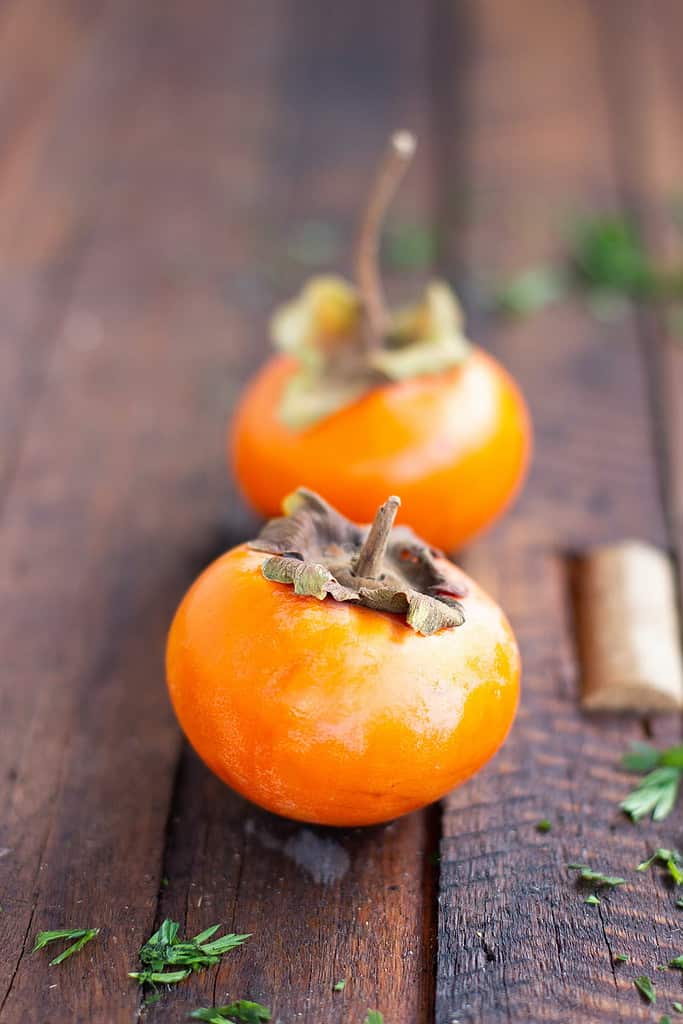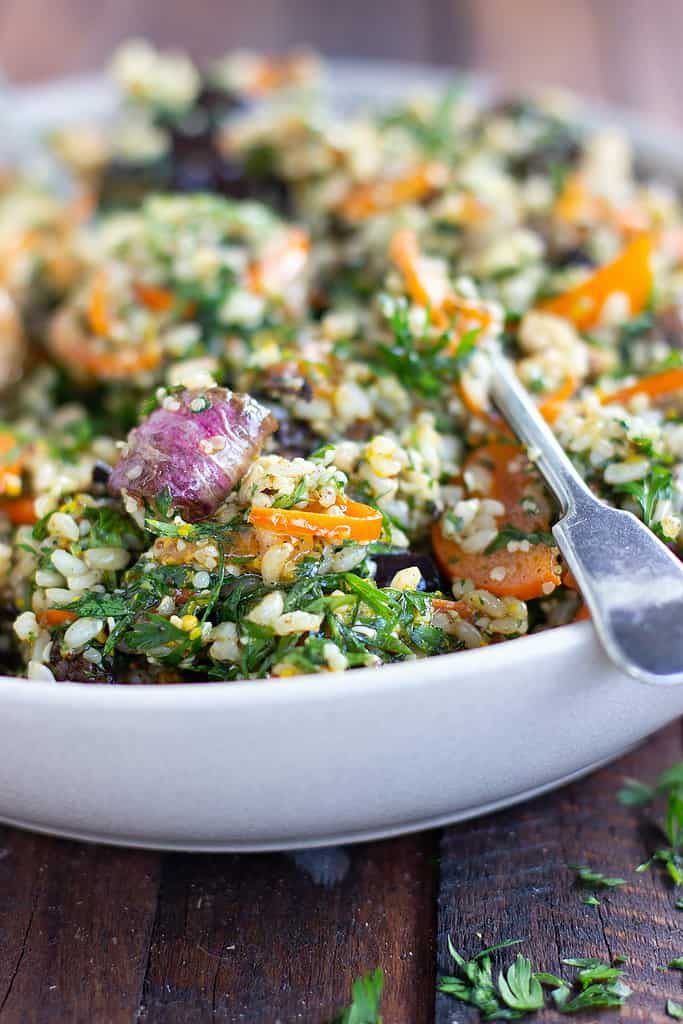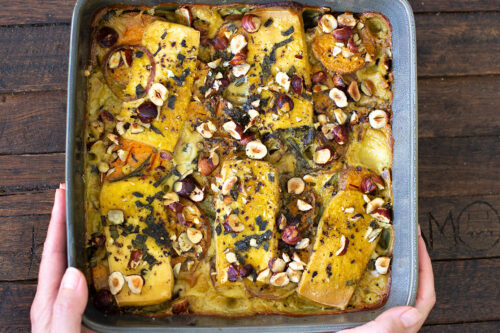
a healthy recipe for using persimmons
Persimmons are one of those fruits that many are unsure of what to do with. In fact, I think there are quite a few ingredients that people are aware of, but tend to take a wide birth around out of an unsureness of what to do with them. Some of us will buy the ‘exotic’ ingredient and take it home proudly, then watch it slowly rot in the fruit bowl or fridge. Persimmons definitely fit into this category, and since they are in full season right now I wanted to encourage you to use them with this Eggplant, Persimmon & Brown Rice Salad w Mustard Dressing recipe.
This Eggplant, Persimmon & Brown Rice Salad w Mustard Dressing recipe teaches you how to use persimmons in really one of the most easiest ways. They are simply sliced up, skin and all (yes you can eat the skin – more on that below), pips removed and tossed through the salad. The sweetness of the persimmons is cut with the tartness of the dressing ingredients. The persimmons have a silky texture, almost a little bit mucilaginous (as we call it in nutritional and naturopathic medicine) that can be truly magnificent for soothing the mucosal membranes of the gastrointestinal tract.


Taste wise, persimmons are almost a mix between the taste of a plum and a mango. They are certainly milder than a mango, however they have a slight natural honey taste. Persimmons can be eaten when quite firm, as they are in the recipe, but as they develop and become softer persimmons can also be enjoyed. In fact this is when they are at their best to incorporate into baking.
What about the skin of persimmons? Can you eat persimmon skin? Yes you can. The persimmon skin flavour is a lot more astringent, but as you may know if you are are a regular reader of my blogs and recipes, astringent flavours are signs of fabulous nutritional benefits. Astringency often denotes a high amount of phytochemical compounds like tannins well known for their gut microbial modulating effects. In fact, studies show that “on eating an astringent persimmon, the tannin cells present in the fruit are crushed and soluble tannins are released thus resulting astringent sensation” (1). Some recent studies (animal based) showed that the tannins in persimmons have direct effect on growth of familes of commensal bacteria (phylum) in the microbiome. (2)

top 10 unused vegetables and fruits
Let’s circle back to the untapped world of fruits & vegetables like the lovely persimmon. Working for many years as Nutritionist at The JCN Clinic in Brisbane (and of course the ‘virtual/online’ national/international surrounds), you get a good wide scope on what we collectively feel comfortable cooking and consuming, adjacent to what seems foreign – consequently becoming an un-used ingredient. As I mentioned, persimmons fall strongly onto this list, but some of the other common ingredients that I find we steer clear of out of a genuine confusion or lack of education of what to do with them are:
- fennel
- kohlrabi
- tarragon
- black sapote
- chestnuts
- celeriac
- artichokes
- mustard greens
- feijoa
- tamarillo
What I find exciting about these ingredients is that usually for those who are on restrictive diets due to gut issues, is that it can open up a world of foods that people can be using without flaring up their symptoms – it’s just a matter of trying some of these alternative ingredients and having the guidance on how to do so. Take chestnuts for instance. Chestnuts are low FODMAP and have a delicious nutty, naturally sweet flavour. They make a divine snack alone roasted in a pan and freshly peeled, but the flour can be used in a multitude of ways to expand the dietary repertoire. For instance, this Castagnaccio is a prime example of where chestnut flour shines.
Fennel is another common vegetable (to me I guess) that many are not using. It substitutes in perfectly for onion when onion cannot be used and has a delectable sweet and caramelised flavour when roasted. The leaves of the fennel plant can be chopped up and tossed through salads and impart a fresh flavour similar to dill.
how to use persimmons
Besides using persimmons in a savoury recipe like this, this fruit can be used in a multitude of ways. You can choose to eat them as they are, taking the skin off if you prefer. Persimmons have an almost ‘plum’ like flavour so they work well in baking. You can add them to cakes and muffins, or dry them and eat them with nuts as a trail mix. The flavour of persimmons also works with game meats and pork, so you can roast them up with a pork shoulder or with duck. Persimmons would also work as an ideal substitute for papaya in my recipe for Choc Chip Quinoa & Papaya Cookies.
Persimmons are also lovely sliced up and served on top of winter porridges and pancakes. I also love them on my Gluten Free Vegan Waffles with almond butter.
Like what you’re seeing? Subscribe for new recipes and nutrition tips every week!
The great thing about persimmons is their versatility. They jump easily from sweet to savoury recipes with ease. This Eggplant, Persimmon & Brown Rice Salad w Mustard Dressing recipe once again is the perfect example of this, marrying sweet flavours with savoury in the perfect union.
So next time you are at the markets or shops and you see persimmons, think twice about passing them by. Now you have a specific recipe to try them with I am sure it will make it even easier to nudge outside those comfort zones and place a few of these beautiful orange fruits in your bag. Hopefully this read (or those persimmons) will also encourage you to try some of the other less popular fruit and vegetables mentioned above. Because really, what’s the worst that can happen with trying a new food? You don’t like it? Fine, at least you know. However if you do, well there opens a whole new world!

Need personalised nutrition advice catered to your needs?
If you are after personalised nutrition advice and dietary planning individualised to your health and dietary needs then contact us at The JCN Clinic with your enquiry. We are always happy to answer any questions you have!
eggplant, persimmon & brown rice salad w mustard dressing recipe
- serves
- 4
- preparation time
- 30 min
- cooking time
- 40 min
ingredients
- 1 medium sized eggplant (460g)
- 1 medium red onion
- ½ cup brown rice
- 1 cup water
- 2 tablespoons extra virgin olive oil
- 1 tablespoon tamari
- 1 tablespoon maple syrup
- 1 teaspoon five spice
- ½ teaspoon salt
- ½ teaspoon pepper
- 1 cup tightly packed parsley
- 2 persimmons, pips removed and finely sliced (skin on)
- ¼ cup cashew nuts
- ¼ cup hemp seeds
dressing
- ¼ cup freshly squeezed orange juice
- ¼ tablespoons extra virgin olive oil
- 3 tablespoons apple cider vinegar
- 2 tablespoons seeded mustard
- ½ teaspoon salt
- ½ teaspoon pepper
- 1 clove garlic
method
Pre-heat your oven to 180c fan-forced.
Rinse brown rice in a colander and then place into a medium saucepan with the water. Bring to the boil and then turn to a low simmer with the lid off. Leave to simmer for around 15 minutes until all of the water has disappeared from the top of the rice and the rice is developing little steam holes (that is the remaining water pushing through the rice from underneath). At this stage place the lid on top of the saucepan and simmer for another 5 minutes, then turn the heat off and leave the saucepan with the lid on for another 10 minutes. This will allow the brown rice to steam really well.
In the interim, slice up the eggplant into large pieces around 2cm wide. Peel the skin off the onion and cut the onion into quarters.
Place the eggplant and onion on a baking tray and then add the extra virgin olive oil, tamari and maple syrup. Toss well with your hands ensuring everything is nicely coated. Now add the five spice, salt and pepper and toss again.
Place the eggplant and onion into the oven for 30 minutes, checking at the 15-minute mark and gentle tossing. The eggplant and onions are done when cooked through and golden.
Remove from the oven and set aside. Place the cashews and hempseeds onto a baking tray and place in the oven to toast for 5 – 7 minutes until golden. Remove and set aside.
Now make your dressing by combining all the dressing ingredients in a small bowl and whisking until combined. Set aside.
To assemble the salad, place the brown rice into a large salad bowl and add the roasted eggplant and onions. Add the chopped parsley, persimmons and the toasted cashews and hemp seeds. Toss everything together till evenly mixed.
Pour over the dressing and mix well again allowing the dressing to soak into the brown rice.
Serve alone or with a protein side of choice.
nutritional information for eggplant, persimmon & brown rice salad w mustard dressing recipe
- Persimmons are rich in an abundance of phytochemical compounds. These include carotenoids (responsible for their lovely orange hue), tannins (such as catechins known by most for its high levels in green tea and matcha), phenolic compounds and proanthocyanidins. Like with many other fruit and vegetablespersimmon peel contains large amount of polyphenolic compounds that help protect the inner flesh. Nature knows best! (3)
- Persimmons are rich in vitamin A and C along with mineral manganese. They are not major hero foods in relation to their general vitamin and mineral content, more so their true beauty shines in there phytochemical content as mentioned above.
Jessica Cox is a qualified practicing Nutritionist with a Bachelor Health Science (Nutrition) and over 15 years of clinical experience. She is the founder and director JCN Clinic, published author and established recipe developer. Jessica is well respected within health and wellness space for her no fad approach and use of evidence-based nutrition.





